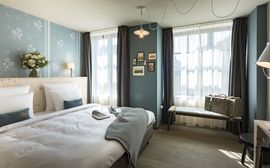"Feeling of home" – back to comfortable Munich originality

Mr Inselkammer, is there really a need for a second Platzl Hotel?
From an economic point of view, yes. Especially during high season, we are bursting at the seams in the parent hotel, with our 167 rooms and suites - further expansion in the area is not possible. But the idea behind the Marias Platzl is more than just greed for growth, and it is not a second Platzl Hotel.
What is it then?
With just 34 rooms - the three categories are called “Anna”, “Gundi” and “Hermine” - it is a small hotel, yet it impresses with a huge amount of charm and a very Bavarian, family character of its very own. Almost like a village in the middle of Munich. A “feeling of home”... We have put our heart and soul into this project, and our grandmother Maria as its namesake, would surely be impressed with the result. Together with my cousin Franz Inselkammer, brewer of the Ayinger private brewery, we - similarly to the hotel - have developed a new pub concept. It should serve as orientation for future Aying pubs and will be called “Ayinger in der Au“. The pub not only adds to the “Platzl” brand but reinterprets it and fills a niche in the neighborhood.
Mr Buchta, which target group should the Marias Platzl appeal to?
It is for guests - both from Germany and internationally, both private and business travelers, who want to experience the original Munich. Those who value proximity to the city and high quality, but have had enough of the global uniform look of the current hotel chains. We certainly don’t have that in our parent hotel either - but the Marias Platzl (with all its loving details and little nostalgic surprises, with its intentionally “smaller” rooms and the typical traditional Munich comfort) takes it a good step further. Once you have stayed at the Marias Platzl, you will fall in love with it, and are guaranteed to choose it again as your favorite home from home, the next time you stay in Munich.
How was this special ambiance created?
Heiko Buchta: First of all it was not a new build, but an old existing building, which had previously been used as a hotel, and has now been carefully renovated and converted in parts. It actually seems as if it has always looked like this. Once the rustic beer garden of the traditional pub has opened, and is filled with life, the “feeling of home” will be even stronger. However, our interior designers from DREIMETA – design studio– have done an unbelievable job in the rooms and public areas: A unique mixture of nostalgic original objects, discreetly concealed technology, and a look like at grandma’s old house.
Mr Fischer, what was the objective for DREIMETA?
At Marias Platzl it was a case of translating Munich tradition into today. Feelings of security, safety and home should be conveyed.
And how did you implement that?
The small but perfectly formed rooms look very homely. They radiate cosiness, and something like homeliness, and should be a snug refuge. Everything fits in with the color concept “Bavaria white and blue” – whereby the blue is more of a light blue - combined with oak parquet and fittings made of pine. The bathroom is designed to be half open, and can be closed with a sliding door. Of course there is a modern TV and Wifi, however, at first glance, the rooms look rather nostalgic. In particular the small details such as the light switches: They are made of Bakelite and should be turned - like 100 years ago. Things like that create atmosphere and astonish the guest.
Word is that some accessories come from the flea market...
Armin Fischer: That’s true. With 34 rooms that is still feasible. For example, every room has an old, typical Bavarian wall mounted holy water basin - which is where the link to the Mariahilfkirche comes from. None of them are the same. Just like the old picture frames which also come from the flea market. Other details are also reminiscent of traditional Bavaria, but are used surprisingly: An enamel bowl serves as a washbasin, the foot of the desk is traditionally turned, but the design language is given a new twist, and the standard lamp was - very innovatively - made from an enamel bucket.
Is there also a link to the traditional “Auer Dult”, which takes place right on the doorstep?
Peter Inselkammer: Yes there is and that was very important to us. The “Auer Dult“ is the largest tableware market in Europe, and takes place three times a year in Mariahilfplatz. That’s why we chose old plates: They serve as original signage to guide the guests through the hotel. The room numbers and other signs were also lovingly painted on plates by hand. There is a small visual highlight in the entrance hall of the hotel, which was designed with a surprising installation made of around 780 old plates on the ceiling and walls.
